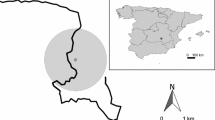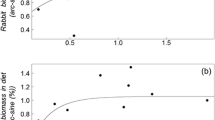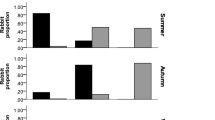Summary
The Eagle Owl (Bubo bubo) is a generalist predator that in Mediterranean areas feeds mainly on Rabbits (Oryctolagus cuniculus) At the end of 1997, a local outbreak of the rabbit haemorrhagic disease (RHD) decimated Rabbit populations in the area of Alicante (eastern Spain) so that Rabbit numbers in 1998 crashed to almost nil. Prior to the outbreak we had found 19 occupied Eagle Owl territories, and the owls had been feeding mainly on Rabbits. After the RHD epidemic, we found only six occupied territories and the owls were still feeding mainly on Rabbits. Diet composition was very similar between the periods, indicating that the owls did not diversify their diet in response to main prey scarcity. No significant differences in the proportion of Rabbit in the diet were found between the periods, suggesting that the impact of predation on Rabbits may be independent of the density of Rabbit populations (type I functional response). This response is not typically associated with generalist predators. In the territories that were still occupied after the outbreaks, the owls took substantial numbers of Hedgehogs (Erinaceus europaeus) and Red-legged Partridges (Alectoris rufa). Rats (Rattus spp), a common alternative prey, were not taken in the study area. Six breeding attempts were recorded before the RHD, and none after the RHD. This leads a to believe that only the combination of Hedgehog and Red-legged Partridge availability with the readier availability of sick Rabbits allowed a small population of owls to survive in the area, but did not allowed breeding. The predator-prey system formed by Eagle Owls and Rabbits in Mediterranean regions is more fragile than previously thought.
Zusammenfassung
Der Uhu (Bubo bubo) ist ein wenig spezialisierter Greifvogel, der sich im Mittelmeerraum hauptsächlich von Kaninchen ernährt. Ende 1997 wurde die Kaninchenpopulation im Gebiet von Alicante (Ostspanien) durch einen Ausbruch der hämorrhagischen Krankheit (RHD) so stark dezimiert, dass der Kaninchenbestand 1998 nahezu zusammengebrochen war. Vor dem Ausbruch der Krankheit waren 19 Uhu-Reviere besetzt, und die Uhus lebten hauptsächlich von Kaninchen. Nach dem RHD-Ausbruch zählten wir nur noch sechs besetzte Reviere; die Uhus ernährten sich aber immer noch hauptsächlich von Kaninchen. Die Zusammensetzung der Nahrung war in beiden Perioden sehr ähnlich, was darauf hinweist, dass Uhus ihr Beutespektrum nicht erweitern, wenn ihr hauptsächliches Beutetier knapp wird. Dies legt nahe, dass die Anzahl geschlagener Kaninchen unabhängig von deren Populationsdichte ist (Typ I funktionelle Reaktion). Diese Reaktion ist untypisch für nicht spezialisierte Greifvögel. In den Revieren, die nach dem Ausbruch der Seuche noch bewohnt waren, fraßen die Uhus eine beträchtliche Anzahl Igel (Erinaceus europaeus) und Rebhühner (Alectoris rufa). Auf gewöhnliche alternative Beutetiere wie Ratten (Rattus spp) wurde im untersuchten Gebiet nicht zurückgegriffen. Sechs Brutversuche waren vor dem RHD-Ausbruch verzeichnet worden, danach kein einziger. Demzufolge lässt sich vermuten, dass nur der vereinte Effekt eines Igel- und Rebhuhnvorrats und darüber hinaus ein größeres Vorhandenseins kranker Kaninchen einer kleinen Anzahl der Uhus das Überleben in dem Gebiet ermöglichte, das Brüten jedoch nicht zuließ. Das im Mittelmeergebiet aus Uhu und Kaninchen bestehende Raubtier-Opfer-System ist anfälliger als bisher angenommen wurde.
Similar content being viewed by others
References
Bayle, P., Orsini, P. & Boutini, J. (1987): Variations du régime alimentarie de Hibou grand-ducBubo bubo en période de reproduction en Basse-Provence. L'Oiseau et R. F. O. 57: 23–31.
Bermejo, S. (2000): Memoria de Caza del Coto de Agua Amarga 1990–2000. Sociedad de Caza de Agua Amarga. Alicante.
Bezzel, E., Obst, J. & Wickl, K-H. (1976): Zur Ernährung und Nahrungswahl des UhusBubo bubo. J. Ornithol. 117: 210–238.
Blondel, J. & Badan, O. (1976): La biologie de Hibou grand-duc en Provence. Nos Oiseaux 33: 189–219.
Cramp, S. & Simmons, K. (1985): The Birds of the Western Paleartic. Vol II. Oxford.
Crawley, M. J. (1992): Natural enemies-the population biology of predators, parasites and diseases. Oxford.
Cugnasse, J. M. (1983): Contribution á l'etúde du Hibou gran-ducBubo bubo dans le sud du Massif Central. Nos Oiseaux 37: 117–128.
Donázar, J. A. (1986): El Búho Real (Bubo bubo) en Navarra: población, análisis de distribución, ecología trófica y crecimiento. Tesis Doctoral. Universidad de Pamplona.
Donázar, J. A. 1987. Geographic variation in the diet of Eagle Owls in western Mediterranean Europe. In: Biology and conservation of Northern Forest Owls Symposium: 220–224. Winnipeg, Manitoba, Canada.
Donázar, J. A. (1990): Geographic variation in clutch and brood size of the Eagle OwlBubo bubo in the Western Paleartic. J. Ornithol. 131: 439–443.
Donázar, J. A., Hiraldo, F., Delibes, M., & Estrella, R. R. (1989): Comparative food habits of the Eagle OwlBubo bubo and the Great-horned OwlsBubo virginianus in six Neartic biomes. Orn. Scand. 30: 298–306.
Galushin, V. M. (1974): Synchronous fluctuations in populations of some raptors and their prey. Ibis 116: 210–213.
Gosálbez, I. M & Noguera, J. (1987): Insectivors y resegadors de Catalunya. Metodología d'estudi y catáleg faunistic. Barcelona.
Greene, H. W. & Jaksic, F. M. (1983): Food-niche relatioonships among sympatric predators: effects of prey level of identification. Oikos 40: 151–154.
Hamerstrom, F. (1979): Effect of prey on predator: voles and harriers. Auk 96: 370–374.
Hiraldo, F., andrada, J. & Parreño, F. F. (1976): Diet of the Eagle OwlBubo bubo in Mediterranean Spain. Doñana Acta Vertebrata 2: 161–177.
Hollings, C. S. (1959): Some characteristics of sample types of predation and parasitism. Canad. Entomol. 91: 385–398.
Jaksic, J. E. & Marti, C. D. (1984): Comparative food habits of Bubo owls in Mediterranean-type ecosystems. Condor 86: 288–296.
Keith, L. B. Todd, A. W., Brand C. J. Adamick R. S. & Rusch, D. H. (1977): An analysis of predation during a cycle fluctuation of snowhares. Proceed. XIII Internat. Congr. Game Biol. 151–175.
Kenward, R. E. (1986): Problems of Goshawk predation on pigeons and other game. Proceed. XVIII Internat. Ornithol. Congr.: 666–677.
Korpimäki, E. & Hongell, E. (1986): Partial migration as an adaptation to nest-site scarcity and vole cycles in Tengalm's OwlAegolius funereus. Vår Fågelv., Suppl. 11: 85–92.
Korpimäki, E. & Norrdall, K. (1991): Numerical and functional responses of kestrels, short-eared owls and long-eared owls to vole densities. Ecology 72: 814–826.
Korpimäki, E., Lagerstörm, M, & Saurola, P. (1987): Field evidence of nomadism in Tengmalm's OwlAegolius funereus. Orn. Scand. 18: 1–4.
Lesne, L & Thevenot, M. (1981): Contribution a l'etude du régime alimentaire du Hibou grandducBubo bubo ascalaphus au Maroc. Bull. 1 Ínstitut Scientifique de Rabat 5: 167–177.
Mikkola, H. (1983): Owls of Europe. London.
Newton, I. (1979): Population ecology of raptors. London
Newton, I. (1993): Predation and limitation of bird numbers. Curr. Ornithol. 11: 143–198.
Newton I., (1998): Population limitation in birds. London.
Olsson, V. (1979): Studies on a population of Eagle Owls. Viltrevy 11: 1–99.
Olsson, V. (1997): Breeding success, dispersal, and long-term changes in a population of Eagle OwlsBubo bubo in southeastern Sweden 1952–1996. Ornis Svecica 7: 49–60.
Ontiveros, D & Pleguezuelos, J. M. (2000): Influence of prey densities in the distribution and breeding success of Bonelli's eagle (Hieraaetus fasciatus): management implications. Biol. Conserv. 93: 19–25.
Orsini, P. (1985): Le régime alimentarie du Hibou Grand-ducBubo bubo en Provence.Alauda 53: 11–28.
Oró, D. & Tella, J. L. (1995): A comparison of two methods for studying the diet of the Peregrine Falcon. J. Raptor Res. 29: 207–210.
Pérez-Mellado, V. (1980): Alimentación del Búho Real (Bubo bubo) en España Central.Ardeola 25: 93–112.
Pianka, E. R. (1974): Niche overlap and diffuse competition. Proc. Nat. Acad. Sci. USA 71: 2141–2145.
Ratcliffe, D. A. (1993): The peregrine falcon. London.
Real, J., Galobart, A. & Frenández, J. (1985): Estudi preliminar d'una població de Duc (Bubo bubo) al Vallés y Bages. Medi Natural del Vallés (1): 175–187.
Redpath, S. M & Thirgood, S. J. (1997): Birds of prey and red grouse. London.
Rico, L. (1991): Informe sobre al Aguila Perdicera (Hieraaetus fasciatus) y el Aguila real (Aquila chrysaetos) en Alicante. Conselleria de Agricultura y Medio Ambiente. Alicante.
Rohner, C. (1997): Non-territorial floaters in Greathorned Owls (Bubo virginianus). In: Duncan, J. R., Johnson, D. H. & Nicholls, T. H. (Eds.): Biology and Conservation of Owls of the Northern Hemisphere: 347–362. Winnipeg, Manitoba, Canada.
Serrano, D. (1998): Diferencias interhábitat en la alimentación del Búho Real (Bubo bubo) en el valle medio del Ebro (NE de España): effecto de la disponibilidad de conejo (Oryctolagus cuniculus). Aredola 45: 47–53.
Smith, J. N. M. (Arcese, P. (1989): How fit are floaters? Consequences of alternative territorial behaviors in a nonmigratory sparrow. Amer. Nat. 133: 830–845.
Smith, D. G., Murphy, J. R. & Woffinden, N. D. (1981): Relationships between jackrabbit abundance and ferruginous hawk reproduction. Condor 83: 52–56.
Souther, H. N. 1970. The natural control of a population of tawny owls (Strix aluco): J. Zool. London. 162. 197–285.
Taylor, I. (1994): Barn Owls. Predator-prey relationships and conservation. Cambridge.
Thiollay, J-M. (1969): Essai sur les rapaces du midi de la France. Distribution-Écologie. Hibou granduc. Alauda 37: 15–27.
Villafurete, R., Calvete, C., Blanco, J. C. & Lucientes, J. (1995): Incidence of viral hemorrhagic disease in wild rabbit populations in Spain. Mammalia 59: 651–659.
Village, A. (1981): The diet and breeding of long-eard owls in relation to vole numbers. Bird Study 28: 215–224.
Wilkman, M. & Linden, H. (1981): The influence of food supply on goshawk population size. In: Kenward, R. E. & Linsay, L. M. (Eds.): Understanding the goshawk. 105–113. London.
Zar, J. H. (1996): Biostatistical Analysis. Englewood Cliffs.
Zuberogoitia. I., (2000): La influencia de los factores meteorológicos sobre el éxito reproductor de la Lechuza Común. Ardeola 47: 49–56.
Watson, J., Rae, S. R. Stillman, R., (1992): Nesting density and breeding success of golden eagles in relation to food supply in Scotland. J. Anim. Ecol. 61: 543–550.
Author information
Authors and Affiliations
Corresponding author
Rights and permissions
About this article
Cite this article
Martínez, J.A., Zuberogoitia, I. The response of the Eagle Owl (Bubo bubo) to an outbreak of the rabbit haemorrhagic disease. J Ornithol 142, 204–211 (2001). https://doi.org/10.1007/BF01651788
Accepted:
Published:
Issue Date:
DOI: https://doi.org/10.1007/BF01651788




